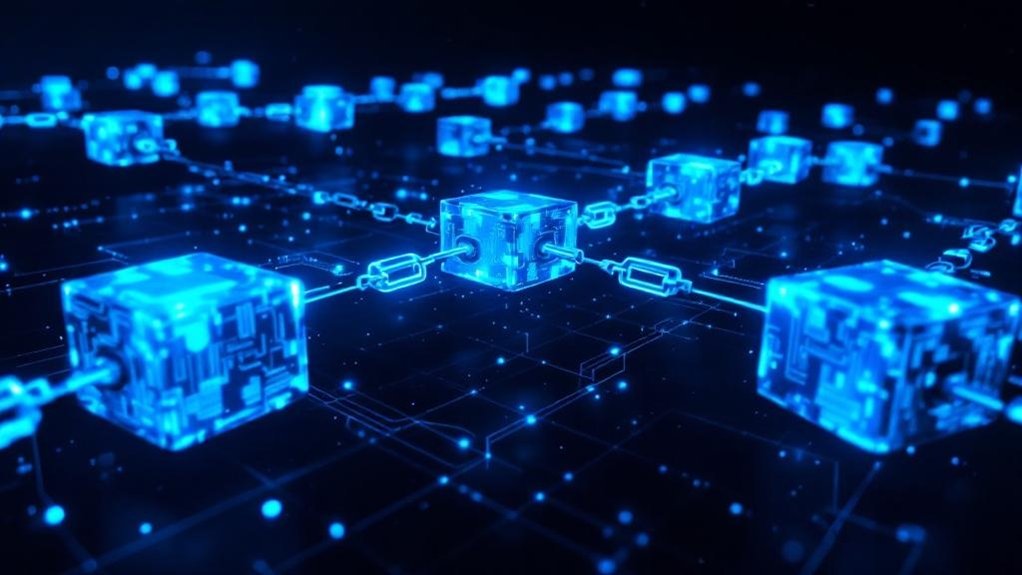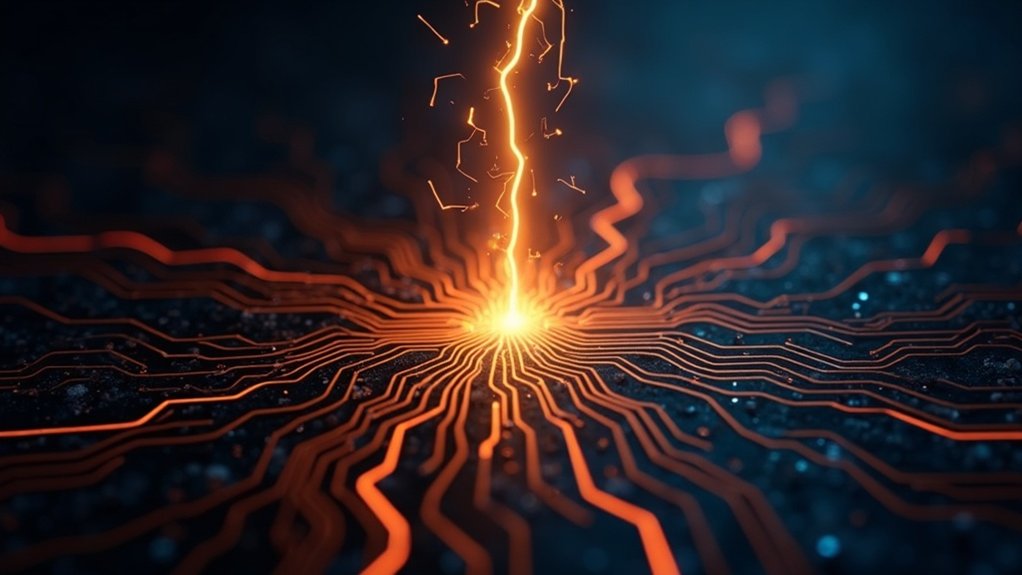A blockchain is a digital record-keeping system that works like a shared database across many computers. It stores information in “blocks” that link together in a permanent chain. Each block contains transaction data, timestamps, and unique codes that connect to previous blocks. The system uses complex math and encryption to keep records secure and unalterable. This decentralized structure eliminates the need for middlemen while ensuring transparency. Understanding its mechanics reveals why it’s revolutionizing digital transactions.

Blockchains represent one of technology’s most innovative developments in record-keeping.
At its core, a blockchain is a digital ledger that’s distributed across many computers in a network.
A blockchain functions as a shared digital record book, spread across countless computers working together in harmony.
This technology first emerged in 2008 as the foundation for Bitcoin, solving the problem of double-spending digital money without needing banks or other middlemen.
The blockchain works like a chain of digital blocks, where each block contains transaction data, a timestamp, and a unique code that links it to the previous block.
This creates an unbreakable chain of information that can’t be changed without detection.
When someone makes a transaction, it’s grouped with other transactions into a block.
Special computers in the network then work to verify this block through a process called consensus.
These blocks are secured using complex mathematics and encryption.
Each block gets its own special code, called a hash, which is like a digital fingerprint.
If anyone tries to change the information in a block, this fingerprint would change, making it obvious that something’s been tampered with.
This makes blockchain records extremely secure and trustworthy.
The immutable ledger ensures that all recorded transactions remain permanently unchanged and transparent.
The system operates through multiple technological layers, including hardware, networking, and applications.
The networking layer helps computers in the system find each other and share information.
The application layer can include smart contracts, which are programs that automatically execute transactions when certain conditions are met.
Smart contracts significantly improve efficiency by automating compliance and data protection through authenticated transactions.
What makes blockchains special is their decentralized nature.
Instead of having one central authority controlling all the data, many computers across the network store copies of the same information.
This means there’s no single point of failure, and it’s very difficult for anyone to manipulate the records.
The technology combines advanced security with Merkle trees to efficiently organize and verify transaction data.
For a change to be made, most computers in the network must agree it’s valid.
Public blockchains are open for anyone to participate in, while private or permissioned blockchains restrict who can validate transactions.
This technology has proven particularly valuable for creating transparent, secure records that don’t rely on traditional intermediaries like banks or government agencies.
Frequently Asked Questions
How Much Energy Do Blockchain Networks Consume Globally?
Bitcoin, the largest blockchain network, consumes about 173 terawatt-hours annually, representing 0.78% of global electricity usage in 2025.
This equals the power consumption of countries like Australia or the Netherlands.
While Bitcoin dominates blockchain energy use, other networks use far less.
Ethereum’s switch to Proof-of-Stake reduced its energy use by 99.9%.
Overall blockchain energy consumption varies as networks adopt more efficient methods.
Can Blockchain Technology Be Hacked or Compromised?
While blockchain networks themselves are highly secure, they can be compromised in several ways.
Hackers can gain control through “51% attacks” if they control most of the network’s computing power. They can also steal private keys from users’ devices, trick people through phishing scams, or exploit weaknesses in smart contracts.
Privacy is another concern, as most transactions can be tracked.
Recent reports show that operational vulnerabilities are more common than direct code attacks.
Which Industries Are Currently Adopting Blockchain Solutions?
Multiple industries are rapidly adopting blockchain technology.
The banking and financial sector leads with 20% of the global market share, using it for secure payments and smart contracts.
Healthcare organizations implement blockchain for patient records and drug tracking.
Supply chain companies use it to monitor goods and verify product authenticity.
Government agencies are applying blockchain for public records, land registries, and digital identity management.
What Programming Languages Are Commonly Used for Blockchain Development?
Several programming languages dominate blockchain development today.
Solidity is the main language for Ethereum smart contracts.
Rust powers high-performance blockchains like Polkadot and Solana.
Go (Golang) supports major projects including parts of Ethereum and Hyperledger Fabric.
Python’s simplicity makes it useful for blockchain prototypes and scripts, while Java’s reliability serves enterprise blockchain solutions.
Each language offers unique strengths for different blockchain applications.
How Do Different Blockchain Platforms Compare in Transaction Processing Speed?
Different blockchain platforms process transactions at widely varying speeds.
Solana leads with up to 65,000 transactions per second (TPS), followed by Polygon at 7,000 TPS and Avalanche at 4,500 TPS.
Traditional platforms like Bitcoin and Ethereum are slower, handling 7 and 25 TPS respectively.
The speed differences stem from their consensus mechanisms – Solana’s Proof of History enables faster processing than Bitcoin’s Proof of Work system.









